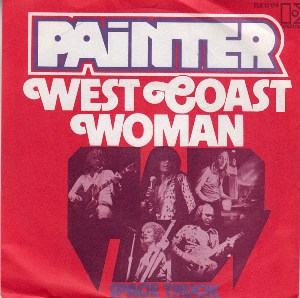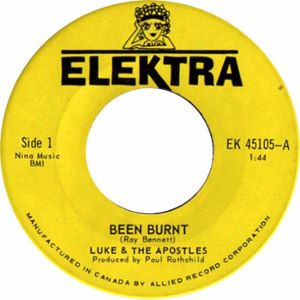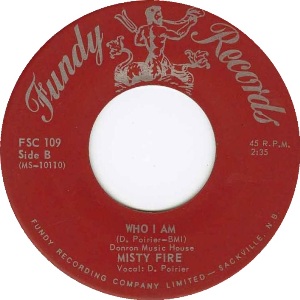| |
Painter

West Coast Woman / Space Truck - 7"
Elektra - 1973
Michael Panontin
|
Painter evolved out of the ashes of the 49th Parallel. That Calgary group achieved a modicum of success with 'Twilight Woman', a song that garnered radio play right across the country, but particularly in the Toronto market, where it reached an impressive #16 slot on CHUM in the early months of 1969. They even released an album that year, but it was a hodgepodge of new and old stuff that sold rather poorly. The group's guitarist, Danny Lowe, eventually decided that a new name and a new sound were in order.
Lowe chose the name Painter on the advice of his friend Randy Bachman, who signed the group to his very short-lived Molten label, issuing their cover of the McCoys' funky rocker 'Daybreak' in the summer of 1970. The single, with its proto-metal riffs and high-pitched vocals, showed if anything that Painter were serious about leaving their psych baggage behind and taking a bold leap into the brave new world of glam and classic rock.
Unfortunately, that also meant a step, so to speak, back to the bars. Which in this case meant the high school circuit around Calgary and Edmonton, and then farther afield to such lofty locales as Sylvan Lake, St. Paul, Grande Prairie, Fort St. John and even Waskatenau, a sleepy town in central Alberta with a population at the time of barely 200 souls.
Things got better. By the spring of 1971, Painter had solidified its lineup around a nucleus of Lowe and singer Doran Beattie, with bassist Wayne Morice and drummer Bob Ego bringing up the rear. Along the way, they appeared on CTV's nationally syndicated Come Together and then in August snagged a coveted slot in support of Procol Harum. They issued a single on little-known West Coast Records in 1972 and then relocated to California, their eyes firmly set on the big time.
"We wanted the interest of a major label in the US," Ego told It's Psychedelic Baby. "We brought our own gear which we would set up, play a song or two for the high ranks, then tear down and move on to the next studio...Some of the record companies were excited enough to record our performances. There was no record deal in place yet but we knew we were getting closer."
They eventually did record, at RCA Studios in Los Angeles and then at Wally Heider Studios in San Francisco, the latter of which resulted in a single ('Country Man') for the London label. Painter returned to Canada tight and flush with confidence. A summer tour in support of the Five Man Electrical Band and some recording sessions at Edmonton's Park Lane Studios drew the attention of Barry Allen, who liked them enough to later join the band as a second guitarist and backup vocalist.
The final piece came along in April 1973 - this was just before Allen joined - when Painter were doing a series of gigs in Vancouver at a place called the Garage on Seymour Street.
"Our first night at the club was really good. A lot of the musicians who were off that night came to see us and were impressed," Morrice recalled. "The second night, Tuesday, the club was packed and then at midnight the Chambers Brothers, who were playing the Cave, came to hear us. At the end of our last set, their manager, Bob Zimmerman, introduced himself and said he wanted to meet the next day. We did meet with him and gave him a demo tape to take to LA."
Zimmerman called back a couple of weeks later. Before long, the guys had signed with Elektra, moved with their families down to Seattle and booked time at Kaye-Smith Studios, likely not knowing that the first song they would record there would be their biggest hit. Lowe and Beattie supposedly wrote it in an hour.
"I knew [engineer Jim Gaines] down in Los Angeles when I was there and followed him up here when he joined Kaye-Smith Sound Studios," Lowe told the Seattle Times back then. "There's a very fresh atmosphere here for writing and playing...We've been a lot more productive since we got here. We wrote 'West Coast Woman' in our motel room just after we moved here."
'West Coast Woman' came out in August 1973 and entered the RPM charts on 8 September. It was classic seventies rock, especially Beattie's soaring vocal and Lowe and Allen's twin guitar assault, which seemed to owe more than a riff or two to Randy Bachman. Within ten days the single was in regular rotation in Seattle, Atlanta and Houston. It was even spun for several weeks on Dick Clark's American Bandstand. Up here in Canada, it managed to work its way up to the 16th position (where it sat nestled right between Helen Reddy's 'Delta Dawn' and Lighthouse's 'Pretty Lady'). It was even issued as far away as Japan and Germany, where it was sheathed in eye-catching picture sleeves.
'West Coast Woman' was included on the group's only LP, Painter, issued the same year (with a cover photo taken in the lobby of Seattle's Paramount Hotel by the legendary photographer Ed Caraeff). But despite some positive words in the press (the Guide, a Seattle arts newspaper, wrote that the group had "taste, class, a few copied licks, and a powerful penchant to rock and roll") and some primo gigs (five nights in Jan '74 at the Whisky a Go Go as well as support slots for Steely Dan, Bob Seger and the J. Geils Band to name a few) Painter were unable to gain much traction. By 1975, Lowe, Beattie and Ego had changed the name again, forming a new band and having another go at it as Hammersmith.
|
|
Suggestions

Rhinoceros
Apricot Brandy / When You Say You're Sorry - 7"
Elektra

Luke and the Apostles
Been Burnt / Don't Know Why - 7"
Elektra

Rush
Not Fade Away / You Can't Fight It - 7"
Moon

George Olliver
I May Never Get to See You Again / Shine - 7"
Much

Misty Fire
Cries of a Gambler / Who I Am - 7"
Fundy
|








